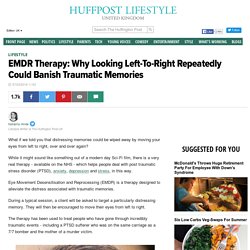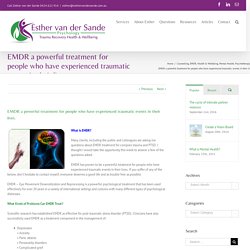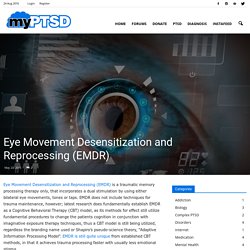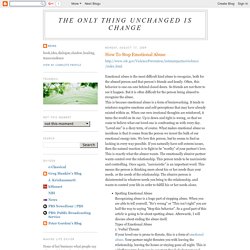

EMDR Lashback - When EMDR Goes Wrong. EMDR Network. A Brief Description of EMDR Therapy The amount of time the complete treatment will take depends upon the history of the client.

Complete treatment of the targets involves a three pronged protocol (1-past memories, 2-present disturbance, 3-future actions), and are needed to alleviate the symptoms and address the complete clinical picture. The goal of EMDR therapy is to process completely the experiences that are causing problems, and to include new ones that are needed for full health. "Processing" does not mean talking about it. "Processing" means setting up a learning state that will allow experiences that are causing problems to be "digested" and stored appropriately in your brain. Phase 1: History and Treatment Planning Generally takes 1-2 sessions at the beginning of therapy, and can continue throughout the therapy, especially if new problems are revealed. Phase 2: Preparation For most clients this will take only 1-4 sessions. Phase 3: Assessment. The Relevance of Intelligence. Eye Movement Desensitization & Reprocessing (EMDR) Therapy.
What Is EMDR?

Eye movement desensitization and reprocessing (EMDR) is a therapeutic style originally developed to address stress, anxiety and depressive symptoms related to traumatic events and memories. EMDR is used to treat posttraumatic stress disorder (PTSD) and has been shown to be effective in this area since its inception. In fact, depending on the level and complexity of trauma, EMDR is known to be effective in as little as one session. Peace of Mind Counseling. "What causes negative thinking?

" TOP The first time we experience something our brain creates a schema or template of that experience and filters all related experiences that follow through that template. If the first experience is unhealthy or negative, then the template that is created will also be unhealthy, which will in turn cause every following experience to be filtered through in an unhealthy way. “So can’t I just take drugs to correct my negative thinking?” TOP. EMDR Therapy: Why Looking Left-To-Right Repeatedly Could Banish Traumatic Memories. What if we told you that distressing memories could be wiped away by moving your eyes from left to right, over and over again?

While it might sound like something out of a modern day Sci-Fi film, there is a very real therapy - available on the NHS - which helps people deal with post traumatic stress disorder (PTSD), anxiety, depression and stress, in this way. Eye Movement Desensitisation and Reprocessing (EMDR) is a therapy designed to alleviate the distress associated with traumatic memories. During a typical session, a client will be asked to target a particularly distressing memory. They will then be encouraged to move their eyes from left to right. The therapy has been used to treat people who have gone through incredibly traumatic events - including a PTSD sufferer who was on the same carriage as a 7/7 bomber and the mother of a murder victim. “You are more able to evaluate and process it in a detached way,” he said. Currently, EMDR is available on the NHS. Also on HuffPost: What is Interoception? - Esther van der Sande.
What is Interoception?

Interoception is our ability to notice what you are feeling. This includes feeling if we you hot or cold, whether you are in pain, hungry or thirsty or even whether you feel happy, sad, safe or frightened. EMDR a powerful treatment for people who have experienced traumatic events in their lives. - Esther van der Sande. What Is EMDR?

Many clients, including the public and colleagues are asking me questions about EMDR treatment for complex trauma and PTSD. I thought I would take the opportunity this week to answer a few of the questions asked. EMDR has proven to be a powerful treatment for people who have experienced traumatic events in their lives. If you suffer of any of the below, don’t hesitate to contact myself, everyone deserves a good life and as trouble free as possible.
EMDR therapy can diminish negative memories and help your wellbeing. The small room is quiet, warm and functional.

Two women are sitting in chairs. One is moving her right hand backwards and forwards in front of the other's eyes, which follow her hand intently. It might sound like a budget hypnosis session but this strange eye flicking ritual is an increasingly popular therapy called Eye Movement Desensitization and Reprocessing (EMDR) which is used for a number of serious conditions, including Post Traumatic Stress Disorder (PTSD), anxiety, depression and common stress. Devotees say simply moving your eyes from left to right between 25 and 30 times can diminish negative memories and, therefore, their impact on your wellbeing. Pedophiles Down Under. Psychology is a horrible and depressing profession which is run by crazy and nasty people.

There are exceptions and I do know some good people who practice – but it’s not worth it. Life’s much better doing something else. – Luciana Cruz, Psychologist I formally studied six years of psychology, specialising in forensics. I was also among the initial intake for Australia’s first art psychotherapy masters program in Perth. The latter course included many hours of Freudian and Jungian group therapy. EMDR Therapy for PTSD and Complex PTSD (CPTSD)
Eye Movement Desensitization and Reprocessing (EMDR) is a traumatic memory processing therapy only, that incorporates a dual stimulation by using either bilateral eye movements, tones or taps.

EMDR does not include techniques for trauma maintenance, however; latest research does fundamentally establish EMDR as a Cognitive Behavioral Therapy (CBT) model, as its methods for effect still utilize fundamental procedures to change the patients cognition in conjunction with imaginative exposure therapy techniques, thus a CBT model is still being utilized, regardless the branding name used or Shapiro’s pseudo-science theory, “Adaptive Information Processing Model”. EMDR is still quite unique from established CBT methods, in that it achieves trauma processing faster with usually less emotional stigma.
Origins EMDR was developed by Dr Francine Shapiro beginning 1987. With her own trauma, she realized that eye movements decreased negative emotion associated with her memories. How To Stop Emotional Abuse. Emotional abuse is the most difficult kind abuse to recognize, both for the abused person and that person's friends and family.

Often, this behavior is one-on-one behind closed doors. So friends are not there to see it happen. But it is often difficult for the person being abused to recognize the abuse. Helping Clients Move Through Partner Emotional Abuse. Helping Clients Move Through Partner Emotional Abuse By Karen R. Koenig, LCSW, MEd Most social workers have at least a few clients—usually female ones—who are emotionally abused by a spouse or partner.
To ensure that these clients keep progressing toward emotional health, a theoretical framework should guide their therapy. Psychological Murder: Death By Covert Abuse. Narcopathic Abuse Victims of this type of abuse are commonly left with no resources they can use to escape the situation; the abuser has stolen their finances, their identity and has turned the victim's own family and friends against them, due to the malicious web of lies and deceit that have been woven. Emotional Abuse: Why Your Individual Therapy Didn't Help and Your Partner's Made it Worse.